Buying Guides by Land & Sea | Kabura & Slider Lures
It’s no secret that the Japanese are one of the more innovative regions regarding product development, testing & general fishing expertise. For decades, they have led the development of the world’s most advanced fishing equipment including Reels, Rods, Accessories & fishing lures. In more recent times, NZ distributors have latched on to the deadly fish-catching ability of Kabura or Tai Rubber lures within home waters.
The Kabura lure was first designed in Japan as a commercial fishing lure, comprising of a sliding weight & a TPE skirt with adjoining hooks. Most commonly used on a long line style rig, Kabura lures provide a method of catching feeding fish with minimal movement in the lure itself, hence the tagline slow jig. Recreational fishermen quickly adopted learnings from this successful technique & subsequently, an array of lures was created.
Over the last decade & a half NZ product developers have been finessing the design of what are now some of the country's most prolific lures. What makes Kabura lures so appealing to a wide audience is the simplicity in which they are fished. We will touch on this in more detail below however the Kabura lure would easily be the most simplistic way of catching the prized Snapper all over NZ.
In this article, we will provide an easy-to-digest buying guide for everything you need to know to thrive in the world of Sliding lures. Kabura-style fishing is one of the more popular methods of harvesting table fish all over the country. As experts in our field, we wanted to share all of our learnings over the years in one place. So to kick things off, here is a full rundown of everything we are going to slide through in this buying guide:
- What is Slow Jig fishing?
- The technique used when fishing my Kabura or sliding lure
- What fish am I targeting when slow jig fishing & where am I fishing?
- The best Kabura / Sliding lures – Our top 5
- What colour slider works best & when?
- The best fishing reels for Slider fishing
- The best fishing rods for slider fishing
- Time of year – When is best to use sliding lures
- Summary
Before we get started, it’s important to note that our team have played a close hand in the development of many of today’s leading products. From the most advanced Kabura style lures to specifically designed Kabura rods, made specifically for the NZ market. We are passionate about passing on our knowledge so that you can have the best fishing experience possible.
So let’s get stuck in…
What is Slow Jig Fishing?
Slow jig fishing is a method of fishing that is exactly as the name suggests; the slow movement of a lure that is designed to attract feeding fish. First implemented within the commercial fishing sector in Japan the method of Kabura fishing fast transitioned into the recreational space. A simple but effective design that consists of three crucial parts. A sliding ‘head’ which you can imagine as a versatile sinker made pretty, a lure skirt made from tough TPE material as found in soft bait lures & a set of twin assist hooks. When applied together the hooks sit inside the TPE skirt with the weighted sinker allowing the angler to move the lure as desired. The lure is then fished in the lower portion of the water collum to attract feeding fish. What makes slider fishing so appealing is the simplicity of the art & how productive the art of lure fishing has been for recreational anglers all over NZ. We will dive more into the exact technique shortly however using a sliding lure is quite possibly the most simple way to target species such as Snapper, Kahawai, Kingfish & much more.
The technique used when fishing my Kabura or sliding lure
We will jump into the equipment used a little later however sliding lures are generally fished on overhead style reels allowing the angler to have full control of the lure. The technique used to fish sliding lures is as simple as the lure itself so don’t get put off by this three-step process.
Release your reel into free spool and simply drop your lure towards the bottom of the target area. Maintain contact with your braid so you can feel any bite during the lures decent. It is common that Snapper, Kahawai & Kingfish will chase your lure on the drop, particularly when fishing in a work-up situation. This is the primary reason we recommend overhead reels, allowing you to remain in contact with the lure at all times. If you do feel bites on the drop simply apply thumb pressure to the spool or click your reel into gear. Generally, before you even start slowly winding you will be hooked up.
When your lure hits the bottom, engage the spool and slowly wind your lure back towards the surface. The speed in which you do this should vary depending on the feeding habits of the fish. We often find if the fish are feeding hard, we wind a little bit faster to entice the bite. Subsequently, when the bite is slow, we slow down the movement of our lure to allow the fish to have a longer look at it. Perform this drop & wind technique continuously until your line angle becomes to horizontal at which time you can reset your drift.
When you feel the nibble of a feeding fish, it’s important not to strike but to maintain a consistent wind of the lure. The skirt is designed to allow the fish to nibble their way up the skirt towards the hooks. You will notice the hooks used within the lure are smaller than conventional hooks we would use when stray lining or ledger rig fishing. This allows the fish to hook themselves and increase hook-up rates.
What fish am I targeting when fishing with sliding lures?
In our many years of fishing this style lure we have caught almost a dozen species of fish including Snapper, Kahawai, kingfish, Gurnard, Trevally, John Dory, Jack Mackerel & even Hapuka. With that said, the primary target species is without a doubt the humble NZ Snapper and boy does it work!
It is important to note that the way you would successfully fish for Snapper may vary slightly around the country. For example, snappers in the Bay of Plenty region generally feed on shellfish hard on the bottom. This means that when we are fishing sliding lures in the BOP we are generally using a bottom bouncing technique. This means we will fish extremely close to the bottom & even use the sand as a way to attract feeding snapper by stirring up the bottom. If we are fishing in areas such as the Hauraki Gulf, Snapper are generally feed on baitfish therefore we will fish a collum of water such as the bottom 10m. It’s a subtle change but one that will directly effect the success of your fishing.
The best Kabura / Sliding lures – Our top 5
Now before we start with this one, I would like to carefully outline our strategy in determining the best 5 slider lures in NZ. We are lucky to stock all of the world’s best slider-style lures here at Land & Sea therefore the first place we started was with our sales data. We then overlaid a few specifics such as longevity, price & our own performance takeaways. Factoring all of this in we can safely land on what are the best 5 Kabura lures in the NZ market, so lets get into it!
1. Daiwa Kohga Bayrubber Kabura – Orange
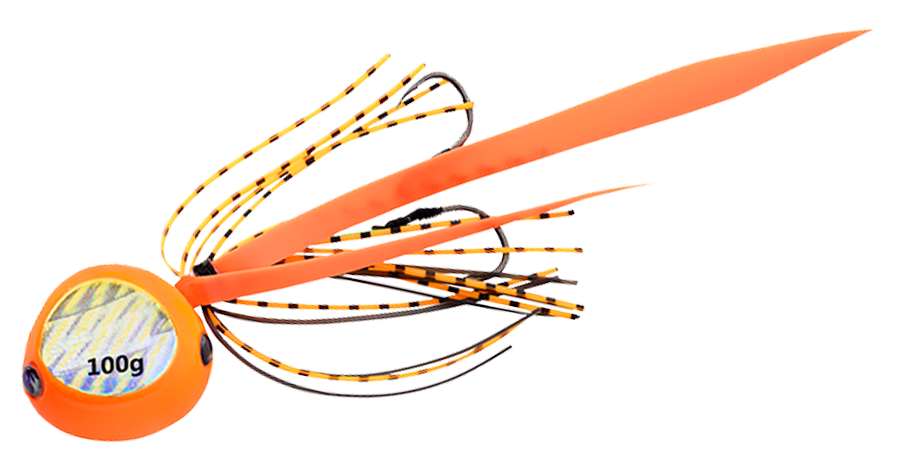
Firstly, death by data. This exact lure is our best-selling slider style lure by 3 to 1 of any other. There are a few things that make this lure our number one pick but we cannot go past its obvious ability to catch a ton of fish. This is a lure that took years of reworking and strengthening before it finally made it onto the NZ market to the Japanese domestic market. A full rework of the componentry including a new kevlar cord, new assist hooks & a redesigned head makes this lure the most specifically designed Kabura for NZ waters.
2. Daiwa Kohga Bayrubber Kabura – Pink
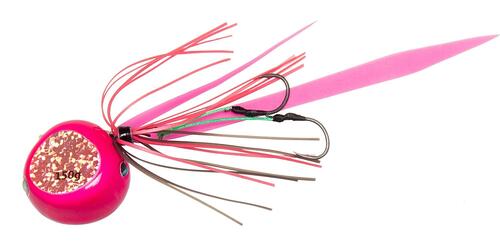
Much like the above Oranga Kohga, the Pink iteration is our second best selling sliding style lure in our business. Combine the impressive componentry used to pre-rig this lure & you have yourself a fish harvesting weapon. The big reason you see two Kohga lures at the top here is their longevity whilst pulling in snapper after snapper. We don’t like to have a hot bite interrupted by the need to change out your skirt or replace a hook. We find if you choose quality, you very rarely regret it!
3. Ocean Angler Kabura Slider Lure – Bruised Banana
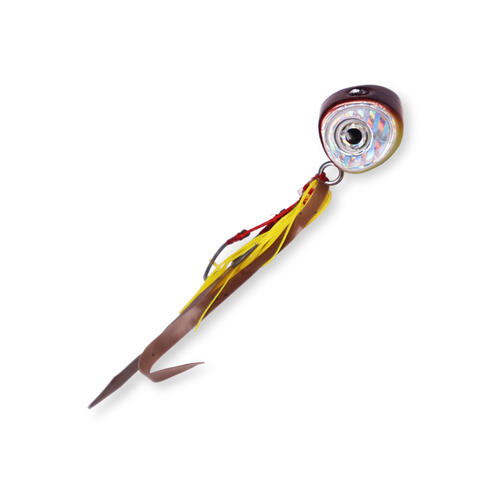
Designed by trusted and experienced product developer Paul Senior, this lure has become a staple for many Kiwi anglers. There is no hiding that Paul has positioned the lure to hit a price point accessible to more anglers & in our opinion, it hits the mark. No it’s not as durable as a Daiwa Kohga, the hooks won’t last as long & you will replace your skirt a little more often but hey, the lure works. This exact lure colour was inspired by the very popular Z-Man bruised Banana & it’s fair to say the transition to a hardbody lure has been successful.
4. Ocean Angler G-Bomb Sliding Lure – Pure Orange
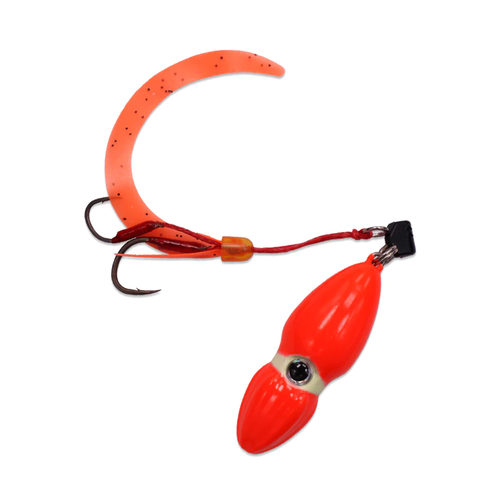
Inspired by yet another Japanese style kabura the G-Bomb has provided slow lures anglers yet another great option when chasing table fish. The unique design provides the lure with a quick descent into the target area. The idea is that you spend more time in the bite zone. When working the lure, little changes and the skirt acts similarly to a conventional Kabura lure. A strong seller for us but also a lure that provides versatility for the angler hence its position in our top 5 Kabura lures!
5. Daiwa Kohga Bayrubber Kabura – Black
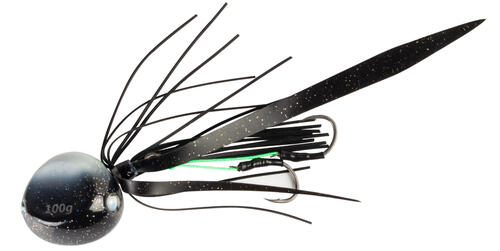
We are going to run through the benefits of having multiple colours of sliding lures in your tackle bag shortly, but black is back! The colour black provides a great option at both dusk & dawn. Much like the OTL Blackjack Lure is our go-to stickbait first thing in the morning, the black Kohga is generally the first lure we grab when arriving at our fishing zone.
What colour slider works best & when?
Best Slider / Kabura for Mornings
When fishing in the early morning we are looking to do one of two things; Cast a shadow with a dark colour that sparks interest or fish a lure that glows to attract the bite. Our two favourite lures during the mornings are Black and the Shakura Glow. Any lure that has a lumo finish should fish well so look for a lure that will stand out to fish in low light conditions.
Best Slider / Kabura for Mid Morning
As the light starts to increase and the fish continue to bite this is the best time to throw in some variety. We often find core colours such as Pink, Yellow or Bruised Banana are great options for the morning bite time. These three colours have proven themselves time and time again, producing great snapper regardless of how hot the bite is on the day. We also find these colours work well during overcast days when light is low and the day is not so bright.
Best Slider / Kabura for during the day
This is potentially why Orange is the number one selling colour in any lure because orange fishes best during the day. Ironically this is also when most anglers are fishing which in our minds makes perfect sense. Orange provides a great option during a clear day & when the bite is a little slow making this colour one of the most versatile colours available from any brand.
Best Slider / Kabura for dusk or evening fishing
As mentioned above, during low light periods we need to think about how we can make our lure stand out to feeding snapper. Generally, this means we look towards lumo or high-vis colours such as chartreuse.
The best fishing reels for Slider fishing
Although it is not uncommon that smaller spin reels are used for slider fishing we tend to recommend overhead-style reels or bait casters. The reason being; to allow the angler to maintain contact with the lure at all times. Some of our biggest fish have been caught on the drop when Snapper & Kingfish are in full feeding mode. The thumb contact with the spool allows us to quickly engage the reel and hook the fish feeding on our lure.
As you will generally be targeting fish over sand, you don’t have to have a reel that packs too much drag. Instead, you can lean towards a finesse reel that offers smoothness & as a result, you will enjoy your fishing much more. A perfect slow jig reel will have around 4-5kg of drag and generally have a gear ratio of 6::3:1. As with any reel, the more ball baring the better & your reel will need to hold at least 200m of 15lb + braid. Here are our top three slow jig reels for 2024.
- Daiwa Light Game IC 150 Baitcaster
- Shimano 23 Curado 200HG Baitcaster
- Shimano Ocea Jigger 1000HG Jigging Reel
The best fishing rods for slider fishing
Before we get stuck into this one, don’t worry too much, we are not looking at another specific fishing rod you need for this style of fishing. Similar to many of your standard bait rods, the best fishing rods for Kabura fishing are generally between 6ft & 7ft in length. They will often be a 2 piece rod in today’s day & age and will often double as a general-purpose slow pitch or bait fishing rod. As we have suggested above we strongly suggest fishing with an overhead reel while slider fishing due to your ability to keep in contact with your lure, therefore we also suggest an overhead rod.
You will find that selective brands have designed rods specifically for Kabura fishing over the years. Our personal favourite has to be the range of Kohga rods from Daiwa. These rods have a specifically designed titanium tip which acted so softly that a biting snapper would not feel the hook set until it was too late. Specifically designed kabura rods will have a very slow taper which means a soft tip to allow the lure to be worked slowly & increase your hook-up rate. Here are our three favourite slow jig rods of 2024:
- JigStar Slow Jerk Acid Wrap PE0.8-1 Slow Jig Rod
- Daiwa TD Zero 691 HB
- Daiwa Exceler Oceano 661XHB
Time of year – When is best to use sliding lures
Fishing with Kabura / sliding lures is absolutely an all-year sport. As the target species spawn & head deeper during the winter months we simply follow them with our selection of lures. As a general rule of thumb, if you follow the bait you will have a great chance of finding your target species. Like any other style of fishing
That being said, this is a form of fishing that has something special to offer during one particular time of year. That is springtime when we are most likely to experience the feeding frenzy that is work-up fishing. To be fair, you could attach hooks to a spanner & find success in some of these impressive workups, but Kabura’s in particular are still our lure of choice. The best time of year to target workups is from September through December when area such as the Hauraki Gulf fill with baitfish. Feeding Snapper, Kahawai & Kingfish follow the bait schools into shallower water and with them comes the Birds, Dolphins & Whales. It’s an impressive thing to witness; thousands of gannets flying head first into these massive schools of bait.
Zooming back out, using Kabura lures is not a technique limited to only a few months of the year. It’s a year-round style of fishing that will produce for you better than most. Our suggestion – keep a rod rigged up at all times to ensure you are only a minute or two away from getting a lure in the bite zone.
Summary
Let me end my sharing the truth on how we are now fishing with our Kabura lures. Honestly, we are trying to do less of it. Sound strange? Yeah, I know but in all seriousness it’s because these lures are so dam good it makes binning up on Snapper way too easy. A standard fishing trip targeting Snapper will now consist of us heading to some pretty rough terrain to chase XOS snapper on soft baits. On a good day, we will release 90% of snapper caught in the shallows as their ability to survive is high. This is one of our favourite sports & if you haven’t got into shallow water soft bait fishing we suggest you give it a crack!
So where does kabura fishing fit into the mix? Well, bet your bottom dollar we are not going home empty-handed. How else do you expect for us to keep the girls happy at home? As I mentioned above, we always have a sneaky Kabura set up on board and often the best way to bin up on Snapper is to drop into a bit of sign on the way home. It’s that simple & ultimately it’s that productive. It shows how much trust we have in these lures and the consistency in which you will get yourself a feed of fish.
If you haven’t tried fishing with Sliders before, get some! If you are a seasoned angler getting bored of how good these things are; mix it up. But one thing I can guarantee is that you will not find an easier way to feed your family.











